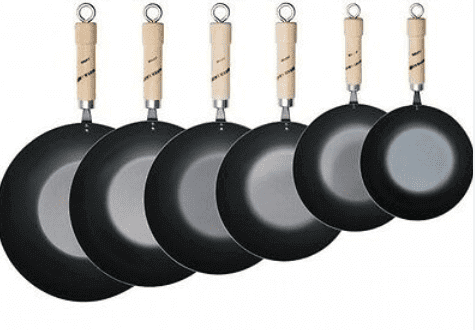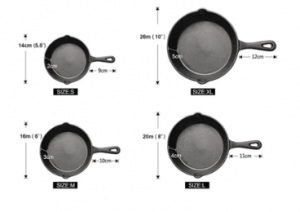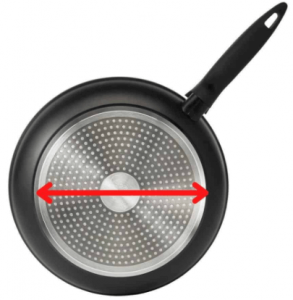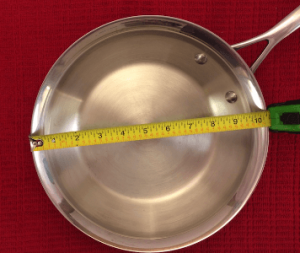How to Measure Frying Pan Size?

Size does matter when it comes to frying pans. The size of your pan can significantly impact the quality of your dishes because not all frying pans are created equal. So, how to measure frying pan size is a common question for many homemakers. Here are a few tips on measuring frying pan size to ensure you get the perfect fit for your cooking needs.
First, measure the diameter of the base of your pan. It will help you to determine the size of the area that will be heated.
 Next, measure the depth of your pan. It will give you an idea of how much food can fit in the pan and how deep it will need to be for proper frying.
Next, measure the depth of your pan. It will give you an idea of how much food can fit in the pan and how deep it will need to be for proper frying.
Finally, determine the handles when measuring the frying pan size. Some handles are longer than others, which can affect how your food cooks and how easily you can maneuver the pan.
How to measure frying pan size (the most straightforward way)?
- On a flat surface, place your frying pan.
- Determine the diameter of the frying pan at its widest part using a measuring tape.
- Decide whether to measure in inches or millimeters.
Sizes Of Frying Pans (Inches) Which one is best for me?
It is true that size matters when it comes to frying pans. 8, 10, 12, and 14 inches are the most typical sizes.
Let’s examine the benefits and drawbacks of each size.
 Pros of an 8-inch frying pan
Pros of an 8-inch frying pan
- Excellent portion control for single dishes or small meals
- Heats up quickly and evenly.
- Easy to maneuver and control.
Cons:
- Small enough for larger meals.
- It can be challenging to flip more oversized items like pancakes or burgers.
Pros of a 10 Inch Frying Pan:
- Perfect size for medium-sized meals or multiple servings.
- It heats up quickly and evenly.
- Easy to maneuver and control with larger items like pancakes or burgers.
Cons:
- Quicker to heat up than the 8-inch pan but still manageable.
- Some food can get stuck in the corners if not stirred properly.
Pros of a 12 Inch Frying Pan:
- A 12” pan allows simultaneous cooking of a large quantity of food.
- You don’t have to bother about becoming overcrowded for larger meals.
- Ideal for oven-safe backing for its better heat retention quality.
Cons:
- Cooled down slowly then the smaller size.
- Not suitable for frying 4 chicken breasts or 6 eggs.
Common uses include: Cooking a pan pizza, galette, or Dutch baby (12″ baking pans are the best size for oven-safe baking). Frying 4 eggs or 3 chicken breasts. Frying bacon strips without having to clip the ends.
Pros of a 14” Frying Pan:
- A 14” pan makes it possible to cook a large amount of food at a time.
- Suitable for large family and family gatherings.
- It saves time by cooking more foods than the smaller ones.
Cons:
- Need more space to store.

So, you may be wondering which frying pan size is best for you? In some situations, the size of the pan matters for reasons other than just the amount of food you will cook. You’re probably fine with a small- or medium-sized pan 8″ or 10″ for your small kitchen, only cooking for one to two people at a time. A larger size 12″ or 14″ frying pan is great if you collect cookware, cook most nights, and have numerous mouths to feed each night.
How to Measure a Frying Pan Lid?
Having the proper instruments is one of the most crucial things when it comes to cooking. In addition, having a frying pan the appropriate size for the meal you are preparing is part of this. If you don’t have a lid for your frying pan, it can be difficult to know how big or small to make it.
In this article, we will give you some tips on how to measure a frying pan lid. One way to measure a frying pan lid is by measuring with tape. Put the tape measure’s end at the frying pan’s edge and extend it up to where you want the lid to reach.
Make sure to mark this measurement, so you know where to stop when measuring future lids. Another way to measure a frying pan lid is by using a ruler. Place the ruler against the frying pan’s side and ensure that one end is touching the bottom of the pan.
Then, hold up the other end until it reaches where you want the top of your lid to be. Again, mark this measurement so you can easily replicate it in future pans. Once you have your measurements, you can use them as a guide when shopping for new lids or making your custom-fit lids at home.
How to Measure Tefal Frying Pan
If you’re looking for a reliable and durable frying pan, Tefal is an excellent option. But how do you know what size to choose? Here’s a quick guide on how to measure a Tefal frying pan.

Finding the frying pan’s diameter is the first thing you must accomplish. You can take measurements from one pan side to the other. Add 3.14 to the diameter once you get it.
You will then have the frying pan’s circumference.
Now that you have the circumference, you can use this formula to figure out the surface area: Surface Area = circumference x height. The height is measured from the pan’s bottom to its top edge.
Keep in mind that these measurements are for a round frying pan. For your Tefal fryer, you will need to adjust the measurements accordingly. Knowing how to measure a Tefal frying pan, choosing the right size will be a breeze!
What is the Largest Size Frying Pan
The largest size frying pan that is commercially available is 20 inches in diameter. This large frying pan is perfect for cooking big meals for a crowd. It can accommodate multiple food items at once, making it an excellent choice for families to get together.
The large size also makes it ideal for cooking big batches of food at once, saving time and effort in the kitchen.
Best Size Pan for 2 Eggs
What is the best size pan for cooking two eggs? It is a common question for many people, especially those new to cooking. The answer depends on how you like your eggs and what type of pan you have available.
A small skillet is probably your best bet if you like your eggs sunny side up or over easy. Just make sure the skillet is well-oiled, so the eggs don’t stick.

In case you prefer scrambled eggs, a medium skillet will work better. Again, a non-stick is not required but can be helpful. Add some butter or oil to the pan and scramble the eggs until they’re cooked to your liking.
A larger skillet can also be used for scrambled eggs, but it will take longer to cook them evenly. If you’re in a hurry, stick with a smaller or medium skillet. So there you have it!
The best size pan for cooking two eggs depends on how you cook them. A small skillet works well for sunny side up or over easy, while a larger one is better for scrambling. Whatever size pan you choose, just make sure it’s well-oiled so your Eggs Benedict doesn’t turn into Egg Disaster!
How is a 10 Inch Frying Pan Measured?
The top of a 10″ frying pan is measured from one side to the other. The distance between the pan’s bottom and the top edge is used to determine the pan’s depth.
What is the Standard Size of a Frying Pan?
There is no standard size for a frying pan, as they come in many different sizes to accommodate different cooking needs. The most popular sizes are 8-10”, 12”, and 14”. Smaller pans are great for cooking eggs or small portions of food, while larger pans can be used for sautéing vegetables or cooking multiple servings.
Consider what you will be using your frying pan for and select the appropriate size accordingly.
Conclusion (how to measure frying pan size):
Frying pan size really matters to have even cooking for a certain amount of people. The diameter of the pan should be proportional to the heat source – a small pan on a large burner will result in uneven cooking, while a large pan on a small burner will take forever to heat up. In general, you want a pan that’s about an inch wider than the element or flame.
As for depth, most home cooks don’t need anything more than two inches; three-inch sides are only necessary if you’re planning on doing some serious searing or braising. And while non-stick surfaces definitely have their benefits, they’re not essential; if you prefer to stick with stainless steel or cast iron, just be sure to use enough oil to prevent sticking (and make sure the pan is hot before adding food).

 Pros of an 8-inch frying pan
Pros of an 8-inch frying pan

Comments(0)